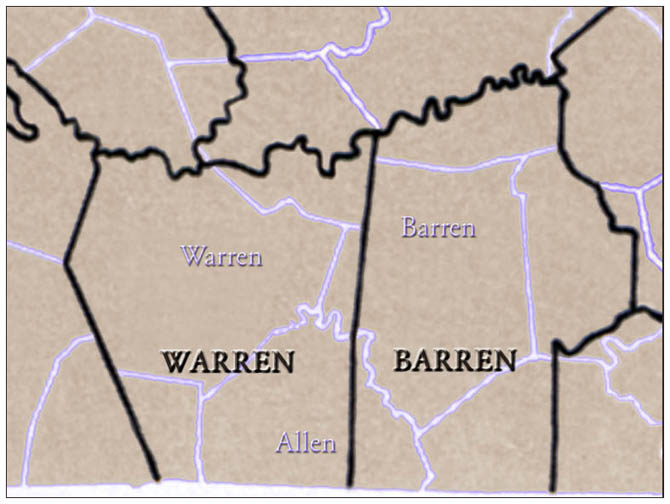

|
Most of what is now the state of Kentucky was originally part of Virginia in the 1700s. In 1776, a part of Fincastle County, Virginia was taken to form Kentucky County. In 1780, Kentucky County was then divided into Fayette, Jefferson, and Lincoln counties. Kentucky became a state on June 1, 1792. On September 1, 1792, Logan County was created from part of Lincoln county, and became the 13th Kentucky county. In turn, Warren County, was created from part of Logan County in 1796, and became Kentucky's 24th county. Barren County was created on December 20, 1798, from parts of Warren and Green counties, and it became Kentucky's 37th county. Allen County, Kentucky's 57th county, was created January 11, 1815, from the south-eastern part of Warren County and south-western part of Barren County. Allen County is bounded in the south by Tennessee and a 15 mile area of disputed land known as "Walker's Line."
Our branch of the Sonoma County Cockrills came to this area of Kentucky and settled there in the first half of the 1800's. The Claypool, Hagans, Venable, Blackburn, Stovall and other familes associated with the Cockrills, arrived in the area at approximately the same time. From an essay by Herbert J. Boothroyd summarizing the material known about the Cockrills (sent to me 12 August 1995): |
|
The families settled along the Walnut Creek, a six mile long tributary of the Big Barren River, in what was then Barren County, since 1815 part of the new Allen County. The earliest settlers had come to this hilly region in 1797, attracted by the heavy virgin timber. By 1803, saw mills were built along these creeks. This part of Barren County came to be known as the "Carolina District", as it was settled 1801-1812 by Anglo Saxons, still speaking Elizabethan English, from the two Carolinas.
|
|
|
|
There is an interesting summary of the early history of Allen County from 1972 which was published in The Citizen-Times in Scottsville, Kentucky and subsequently made available as a link on the web. An almost "first hand" description of this area of Kentucky during the early 1800's can be found in the forward to Allen County, Kentucky Tax Records, compiled by Jeanette Steenbergen Gardner (privately published, 1999): |
|
...I'm going to quote from the autobiography of my great uncle John Henderson Spencer... John Spencer, his grandfather, came to what is now Allen County in 1796 from Shawnee Run in Mercer County and raised a crop of corn... When he returned to Mercer County and made his report concerning the goodly land, his father and others of his kindred, immediately pulled up stakes and set out for the land of promise. They all settled in 1797, in the N E corner of Allen County on Walnut, Hurricane and Big Difficult Creeks, near the Big Barren River. The country was gently undulating, rather than hilly. An intense unbroken forest covered the whole region between Barren River and the Tennessee line. The trees were of great size, comprising many species, among which were Popular, Chestnut, Ash, Black Walnut, White Walnut, Hickory, several varieties of Oak, Elm, Honey Locust, Hackberry, Beech, and Sugar Maple. The last named was of special value to the settlers since form it they manufactured nearly all the sugar and molasses they used for more than a third of a century after the country began to be settled. The undergrowth comprised redbud (valuable in the manufacture of gun powder), dogwood, sumac, sassafras, persimmon, pawpaw, spicewood and hazel. Immense canebrakes covered a large portion of the richest uplands. Bear, elk, deer, and wild turkeys with smaller game, were abundant, and all the streams teemed with excellent varieties of fish. The peavines and other nutritious vegetation in summer, and the canebrakes in winter, furnished abundant supplies of food for cattle and horses and there was an abundance of nuts and acorns for all the hogs the settlers needed. The soil was fertile, and water was plentiful and of excellent quality. Cotton, flax and wool, for home consumption, were easily produced, and wives and grown up daughters of the settlers were skilled in spinning and weaving them into fabrics, and in making the fabrics into garments. The skins of wild animals were also dressed and made into garments, caps and moccasins for the men. Perhaps there was no spot on our globe where men could live better with so little labor...
|
|
|
This page created on 04/04/04 16:01. Updated 12/27/04 12:47.